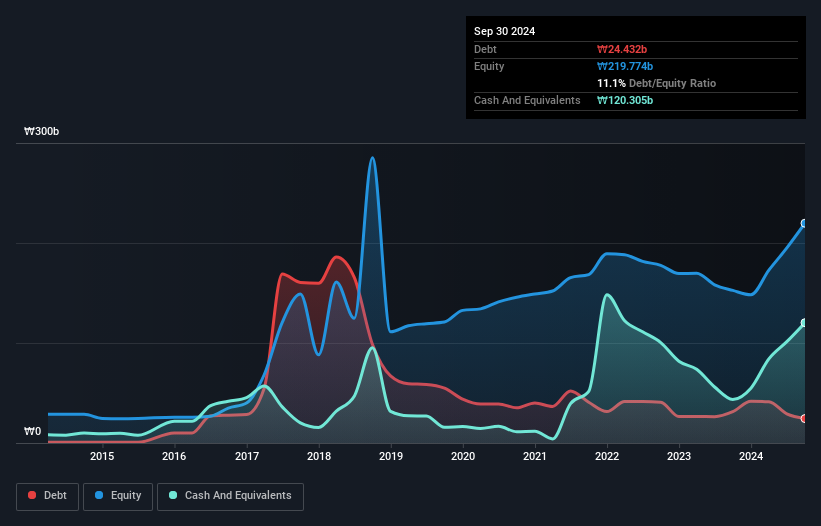- South Korea
- /
- Retail Distributors
- /
- KOSDAQ:A064800
Does PonyLink (KOSDAQ:064800) Have A Healthy Balance Sheet?
Some say volatility, rather than debt, is the best way to think about risk as an investor, but Warren Buffett famously said that 'Volatility is far from synonymous with risk.' So it might be obvious that you need to consider debt, when you think about how risky any given stock is, because too much debt can sink a company. We note that PonyLink Co., Ltd. (KOSDAQ:064800) does have debt on its balance sheet. But the more important question is: how much risk is that debt creating?
When Is Debt Dangerous?
Debt and other liabilities become risky for a business when it cannot easily fulfill those obligations, either with free cash flow or by raising capital at an attractive price. If things get really bad, the lenders can take control of the business. However, a more usual (but still expensive) situation is where a company must dilute shareholders at a cheap share price simply to get debt under control. Of course, plenty of companies use debt to fund growth, without any negative consequences. When we think about a company's use of debt, we first look at cash and debt together.
Check out our latest analysis for PonyLink
What Is PonyLink's Debt?
As you can see below, PonyLink had ₩24.4b of debt at September 2024, down from ₩31.3b a year prior. However, it does have ₩120.3b in cash offsetting this, leading to net cash of ₩95.9b.

How Strong Is PonyLink's Balance Sheet?
The latest balance sheet data shows that PonyLink had liabilities of ₩30.6b due within a year, and liabilities of ₩1.80b falling due after that. On the other hand, it had cash of ₩120.3b and ₩13.1b worth of receivables due within a year. So it actually has ₩101.0b more liquid assets than total liabilities.
This luscious liquidity implies that PonyLink's balance sheet is sturdy like a giant sequoia tree. On this view, lenders should feel as safe as the beloved of a black-belt karate master. Simply put, the fact that PonyLink has more cash than debt is arguably a good indication that it can manage its debt safely. When analysing debt levels, the balance sheet is the obvious place to start. But it is PonyLink's earnings that will influence how the balance sheet holds up in the future. So when considering debt, it's definitely worth looking at the earnings trend. Click here for an interactive snapshot.
Over 12 months, PonyLink made a loss at the EBIT level, and saw its revenue drop to ₩70b, which is a fall of 2.6%. That's not what we would hope to see.
So How Risky Is PonyLink?
Statistically speaking companies that lose money are riskier than those that make money. And the fact is that over the last twelve months PonyLink lost money at the earnings before interest and tax (EBIT) line. Indeed, in that time it burnt through ₩13b of cash and made a loss of ₩20b. But the saving grace is the ₩95.9b on the balance sheet. That means it could keep spending at its current rate for more than two years. Overall, its balance sheet doesn't seem overly risky, at the moment, but we're always cautious until we see the positive free cash flow. The balance sheet is clearly the area to focus on when you are analysing debt. But ultimately, every company can contain risks that exist outside of the balance sheet. To that end, you should learn about the 3 warning signs we've spotted with PonyLink (including 2 which don't sit too well with us) .
If you're interested in investing in businesses that can grow profits without the burden of debt, then check out this free list of growing businesses that have net cash on the balance sheet.
New: Manage All Your Stock Portfolios in One Place
We've created the ultimate portfolio companion for stock investors, and it's free.
• Connect an unlimited number of Portfolios and see your total in one currency
• Be alerted to new Warning Signs or Risks via email or mobile
• Track the Fair Value of your stocks
Have feedback on this article? Concerned about the content? Get in touch with us directly. Alternatively, email editorial-team (at) simplywallst.com.
This article by Simply Wall St is general in nature. We provide commentary based on historical data and analyst forecasts only using an unbiased methodology and our articles are not intended to be financial advice. It does not constitute a recommendation to buy or sell any stock, and does not take account of your objectives, or your financial situation. We aim to bring you long-term focused analysis driven by fundamental data. Note that our analysis may not factor in the latest price-sensitive company announcements or qualitative material. Simply Wall St has no position in any stocks mentioned.
About KOSDAQ:A064800
PonyLink
Primarily engages in the provision of mobility, distribution, and information technology businesses in South Korea and internationally.
Adequate balance sheet with acceptable track record.
Market Insights
Community Narratives


Recently Updated Narratives

TAV Havalimanlari Holding will fly high with 25.68% revenue growth


Fiducian: Compliance Clouds or Value Opportunity?


Q3 Outlook modestly optimistic
Popular Narratives


MicroVision will explode future revenue by 380.37% with a vision towards success


The company that turned a verb into a global necessity and basically runs the modern internet, digital ads, smartphones, maps, and AI.



